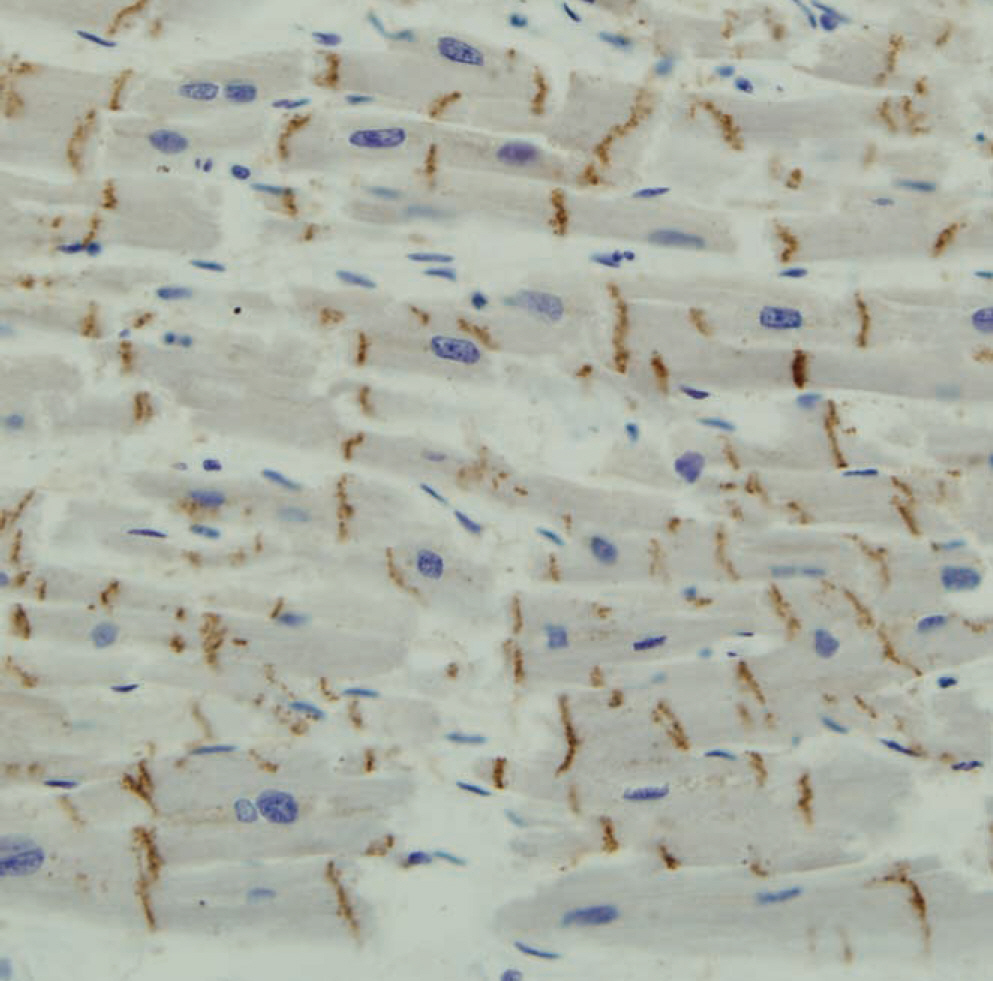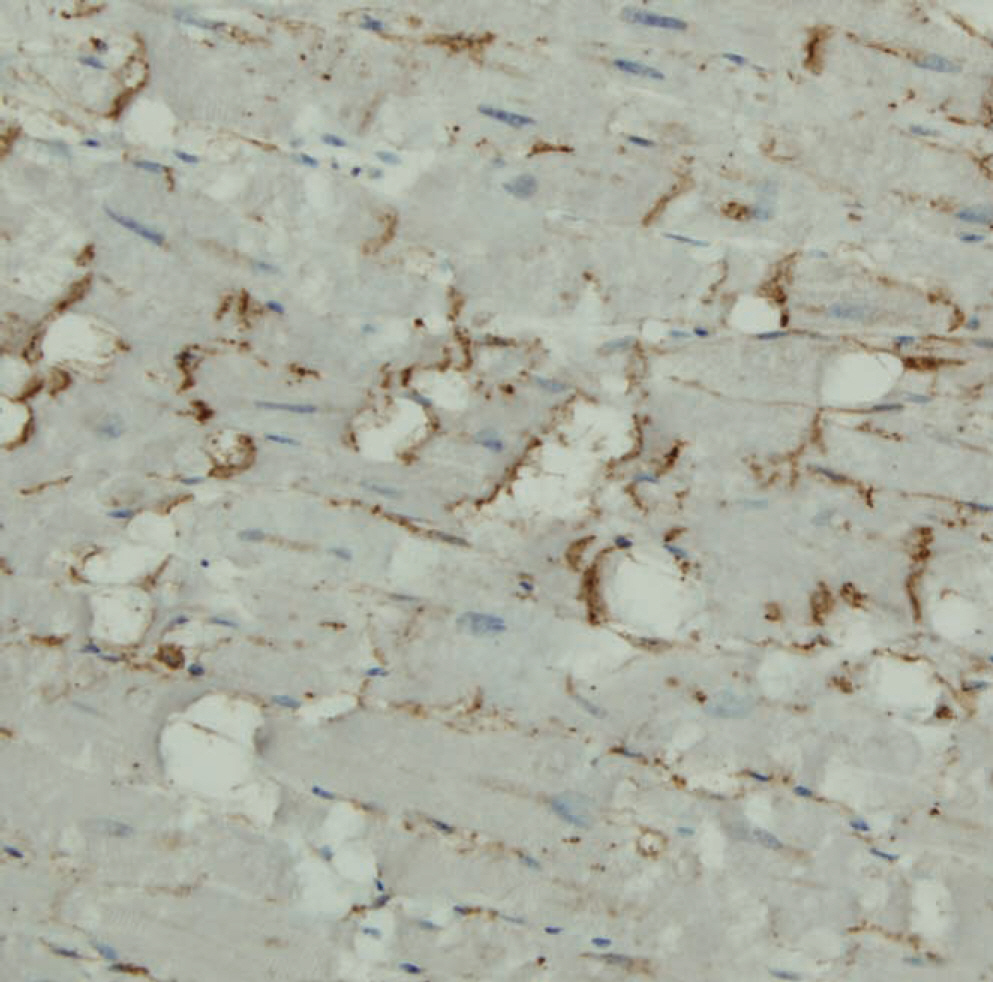Korean J Leg Med.
2015 Feb;39(1):6-11. 10.7580/kjlm.2015.39.1.6.
The Efficacy of Connexin 43 Expression in the Myocardium as an Early Ischemic Marker in Forensic Autopsy
- Affiliations
-
- 1Department of Forensic Medicine, Pusan National University School of Medicine, Yangsan, Korea. gyhuh@pusan.ac.kr
- KMID: 1785232
- DOI: http://doi.org/10.7580/kjlm.2015.39.1.6
Abstract
- The postmortem diagnosis of ischemic heart disease is sometimes difficult for forensic pathologists especially when microscopic ischemic change in the myocardium is not detected at the early stages of ischemic injury by conventional staining techniques. Connexin 43 (Cx43) is a gap junction protein in human myocardium, which is phosphorylated and localized to the intercalated discs in the normal cardiac muscles. However, during ischemia and hypoxia, total Cx43 (tCx43) undergoes progressive dephosphorylation and concomitant accumulation of non-phosphorylated Cx43 (npCx43) at the lateral cell borders. This study was aimed to evaluate the efficacy of the immunohistochemical expression of Cx43 in the myocardium as an early ischemic marker in forensic autopsy. The study group consisted of 24 cases listing patients who died of ischemic heart disease (IHD) with severe coronary atherosclerosis that showed no myocardial pathology. Cases of sudden death of individuals from non-IHD (n=16) were used as controls. The survival times in both IHD and non-IHD groups were within 24 hours of the onset of angina symptoms, related injury, or the event for the cause of death. There was a statistically significant difference in tCx43 and npCX43 immunopositivity in the IHD group due to their expression patterns. In the IHD group, the redistribution of Cx43 expression from the intercalated discs to the lateral cell borders occurred more frequently than in the non-IHD group. In conclusion, the different expression patterns of tCx43 and npCx43 in the myocardium in IHD could be used as adjunctive ischemic markers.
MeSH Terms
Figure
Reference
-
1. Na JY, Park JP, Park HJ, et al. The statistical analysis on legal autopsy performed in Korea during 2012 year. Korean J Leg Med. 2013; 37:198–207.
Article2. Saukko P, Knight B. Knight's forensic pathology. 3rd ed.London: Arnold;2004. p. 495–502.3. Laird DW. Life cycle of connexins in health and disease. Biochem J. 2006; 394:527–43.
Article4. Beardslee MA, Lerner DL, Tadros PN, et al. Dephosphorylation and intracellular redistribution of ventricular connexin43 during electrical uncoupling induced by ischemia. Circ Res. 2000; 87:656–62.
Article5. Turner MS, Haywood GA, Andreka P, et al. Reversible connexin 43 dephosphorylation during hypoxia and reoxygenation is linked to cellular ATP levels. Circ Res. 2004; 95:726–33.
Article6. Hatanaka K, Kawata H, Toyofuku T, et al. Down-regulation of connexin43 in early myocardial ischemia and protective effect by ischemic preconditioning in rat hearts in vivo. Jpn Heart J. 2004; 45:1007–19.
Article7. Matsushita S, Kurihara H, Watanabe M, et al. Alterations of phosphorylation state of connexin 43 during hypoxia and reoxygenation are associated with cardiac function. J Histochem Cytochem. 2006; 54:343–53.
Article8. Ortmann C, Pfeiffer H, Brinkmann B. A comparative study on the immunohistochemical detection of early myocardial damage. Int J Legal Med. 2000; 113:215–20.
Article9. Campobasso CP, Dell'Erba AS, Addante A, et al. Sudden cardiac death and myocardial ischemia indicators: a comparative study of four immunohistochemical markers. Am J Forensic Med Pathol. 2008; 29:154–61.10. Kawamoto O, Michiue T, Ishikawa T, et al. Immunohistochemistry of connexin43 and zonula occludens-1 in the myocardium as markers of early ischemia in autopsy material. Histol Histopathol. 2014; 29:767–75.
- Full Text Links
- Actions
-
Cited
- CITED
-
- Close
- Share
- Similar articles
-
- Expression of Connexin 43 in the Myocardium in Sudden Unexplained Nocturnal Death Syndrome
- Examination of Abdominal Organ in Forensic Autopsy
- Profile of Forensic Autopsy Practices in Small Towns and Cities in Rural Areas
- A study on the expression of connexin 43 in the experimental tooth movement of rat
- Forensic Pathology of the Lung in Fetus and Infant




